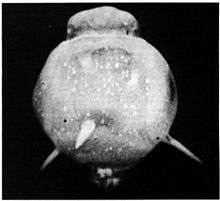Rope trick effect

Rope trick is the term given by physicist John Malik to the curious lines and spikes which emanate from the fireball of certain nuclear explosions just after detonation.
Description
The photograph on the right shows two unusual phenomena: bright spikes projecting from the bottom of the fireball, and the peculiar mottling of the expanding fireball surface.
The surface of the fireball, with a temperature over 20,000 kelvin, emits huge amounts of visible light radiation (more than 100 times the intensity at the sun's surface). Anything solid in the area absorbs the light and rapidly heats. The "rope tricks" which protrude from the bottom of the fireball are caused by the heating, rapid vaporization and then expansion of mooring cables (or specialized rope trick test cables) which extend from the shot cab (the housing at the top of the tower that contains the explosive device) to the ground. Malik observed that when the rope was painted black, spike formation was enhanced, and if it were painted with reflective paint or wrapped in aluminium foil, no spikes were observed – thus confirming the hypothesis that it is heating and vaporization of the rope, induced by exposure to high-intensity visible light radiation, which causes the effect. Because of the lack of mooring ropes, no "rope trick" effects were observed in surface-detonation tests, free-flying weapons tests, or underground tests.

The cause of a surface mottling is more complex. At the point in the explosion captured in the above photo, a hydrodynamic shock front has just formed. Before this point in time, the growth of the fireball was due to radiative transport, i.e. thermal x-rays "outpaced" the actual expanding bomb debris. At this point of the explosion, the fireball expansion is caused by the shock front driven by hydrodynamic pressure (as in a conventional explosion, only far more intense). The glowing surface of the fireball is due to shock compression heating of the air, thus the fireball is at this point growing at a much slower rate than when it was in the radiatively driven stage. In the first few microseconds after detonation, the bomb and shot cab are destroyed and vaporized. These vapors are then accelerated to very high velocities (several tens of kilometers per second) outward, and the clustered masses of varying vapor density of this material are splashing against the back of the shock front in an irregular pattern due to initial variations in mass distribution around the bomb core. This effect thus creates the mottled blob-like appearance.[1]
After a few milliseconds, the energy of the shock front will no longer be great enough to heat the air into incandescence. At this point the shock front becomes invisible, a process known as "breakaway". This makes the shock wave difficult to diagnose. Photographs of atomic tests often show numerous vertical rope-like lines to one side. These are typically created by small sounding rockets launched a few seconds before the firing, leaving smoke trails. The purpose of these trails is to record the passing of the now invisible shock wave, which causes an obvious visual effect on the smoke by compressing the air into a lens. This is not necessarily related to the rope trick effect in any physical way, although it is possible to use vertical cables heated by the rope trick in place of the rockets. It is possible to confuse the two in some photographs. In this photograph, the smoke trails are (faintly) visible in the lower-right corner.
Camera recording

The photo was shot by a rapatronic camera (a high speed camera invented by Harold Edgerton and colleagues) built by EG&G.[2][3] Each camera was capable of recording only one exposure on a single sheet of film. To create time-lapse sequences, banks of four to ten cameras were set up to take photos in rapid succession. The average exposure time was three microseconds.
References
- ↑ Carey Sublette (June 19, 2002). "Operation Tumbler-Snapper / "Rope Tricks"". Retrieved 2007-03-27.
- ↑ Rapatronic Photographs
- ↑ "EG&G the Company: 1947 Onwards « Harold "Doc" Edgerton". 2009-11-28. Retrieved 2009-11-28.
- This article incorporates text from U.S. Department of Energy, National Nuclear Security Administration, Nevada Site Office, Office of Public Affairs.